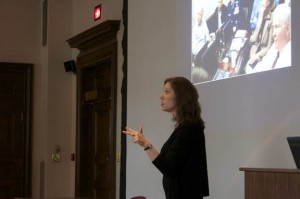By Geoff Gehman ’80
Two dozen spectators in a Kirby Hall lecture room are watching a video of two basketballs passed by a half dozen people. After the video ends they’re asked to count the number of passes. Their answers range wildly, from 11 to 26.

Amy Herman '88 explains how to notice the important details.
Then they’re asked if they noticed the person in the gorilla suit who sauntered into the video, stopping to beat his or her chest before leaving the frame. Only half raise their hands.
Amy Herman ’88 uses this exercise to remind the audience that most viewers overlook the most obvious facts, especially when they’re confronted by conflicting information. Teaching people how to read complex scenes more accurately is a key component of “The Art of Perception,” her program aimed at improving observation and communication for people in positions of high responsibility. For 11 years the trained art historian and “recovering” lawyer has used pictures, particularly of works of art, to help everyone from nurses to law-enforcement officers create a sharper portrait of “the big picture.”
Herman’s 2011 Reunion College lecture is a condensed version of her three-hour seminar. She sets a few ground rules, asking spectators to analyze pictures without saying “clearly” or “obviously.” Then, with the enthusiasm of a motivational speaker, she coaches them as they compare pairs of similar paintings by the same artists. No one, she points out, notices that a woman in an Edward Hopper work has only one glove. No one mentions that just because Paul Cezanne’s men are holding playing cards means they are actually playing cards.
Paying close attention to body language is important to art historians, and critical to criminal investigators. Herman notes that body language led to the arrest of a suspect in the murder of a female graduate student at Yale University. An investigator grew suspicious when the suspect, a male lab technician, kept blocking her view of a box of sanitary wipes stained by blood.
“People speak volumes about themselves without opening their mouths,” says Herman. “Small details make a big difference. Small details solve big problems and crimes.”
Herman launched “The Art of Perception” in 2000 to help medical students treat patients more carefully. Her tools were paintings at the Frick Collection in Manhattan, where she assisted the museum’s director. Prompted by a friend, and prodded by the memory of a scary police patrol run as a law student, she decided to expand her clientele to law-enforcement officers.
Six months after offering her services to the New York City Police Academy, Herman began teaching NYPD captains at the Frick. After the Wall Street Journal ran a 2005 story on her system of aesthetic forensics, she received invitations to work with the Secret Service and the FBI. Since then she has collaborated with the CIA, Department of Homeland Security, and Metropolitan Police of Scotland Yard.
Herman faces plenty of obstacles. Her rivals range from cocky cops skeptical of advice from “any museum lady” to educated professionals who make the most absurd assumptions. Herman recalls an attendee at a government-security exposition who insisted a bearded cellist in a painting was Jewish because, after all, “all musicians are Jewish.”
According to Herman, many mistakes involve race biases. As proof, she screens a photograph of a woman of color holding a Caucasian infant. Many viewers, she says, assume the pair are biologically related “because it’s politically correct.” No one has detected that the boy in the picture is actually Herman’s son, and the woman is his Trinidadian nanny.
Herman left her audience with a list of suggestions. Don’t avoid the ultra-sensitive elements of race and gender. Avoid using the vague term “middle age.” Observe before you infer; gather as many facts as you can before you judge. “As long as you can account for what you say,” she says, “it’s okay to be wrong.”
